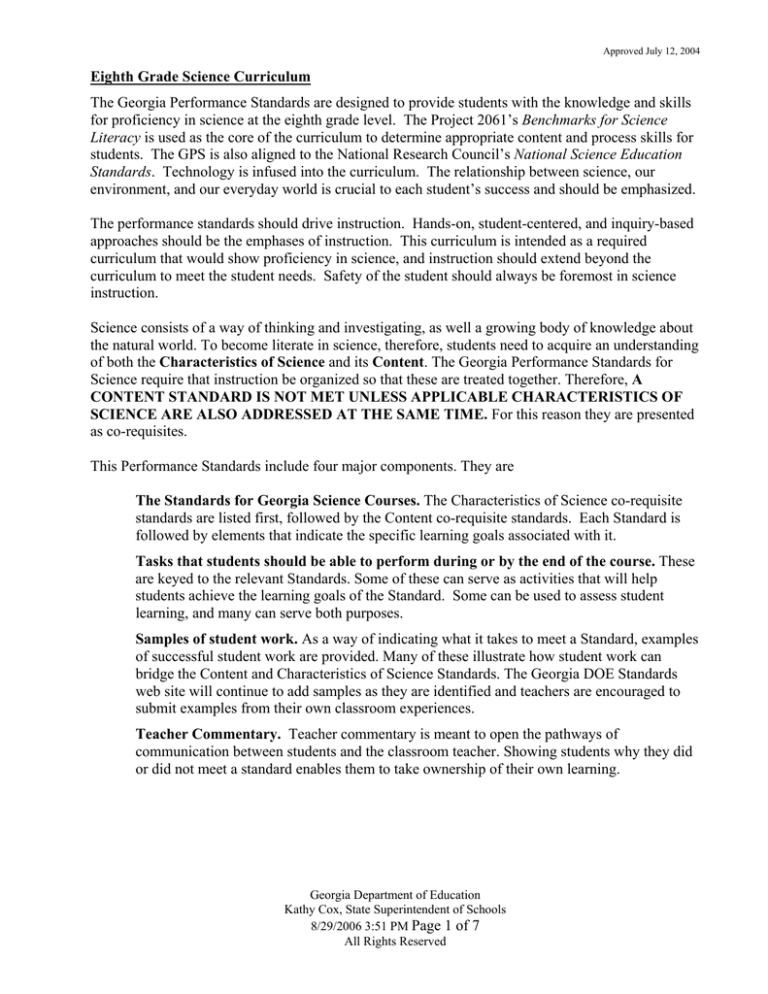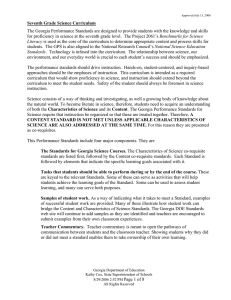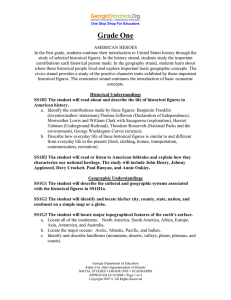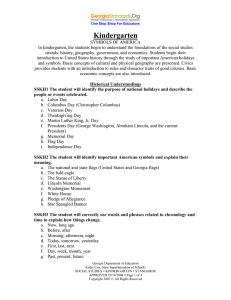
Approved July 12, 2004
Eighth Grade Science Curriculum
The Georgia Performance Standards are designed to provide students with the knowledge and skills
for proficiency in science at the eighth grade level. The Project 2061’s Benchmarks for Science
Literacy is used as the core of the curriculum to determine appropriate content and process skills for
students. The GPS is also aligned to the National Research Council’s National Science Education
Standards. Technology is infused into the curriculum. The relationship between science, our
environment, and our everyday world is crucial to each student’s success and should be emphasized.
The performance standards should drive instruction. Hands-on, student-centered, and inquiry-based
approaches should be the emphases of instruction. This curriculum is intended as a required
curriculum that would show proficiency in science, and instruction should extend beyond the
curriculum to meet the student needs. Safety of the student should always be foremost in science
instruction.
Science consists of a way of thinking and investigating, as well a growing body of knowledge about
the natural world. To become literate in science, therefore, students need to acquire an understanding
of both the Characteristics of Science and its Content. The Georgia Performance Standards for
Science require that instruction be organized so that these are treated together. Therefore, A
CONTENT STANDARD IS NOT MET UNLESS APPLICABLE CHARACTERISTICS OF
SCIENCE ARE ALSO ADDRESSED AT THE SAME TIME. For this reason they are presented
as co-requisites.
This Performance Standards include four major components. They are
The Standards for Georgia Science Courses. The Characteristics of Science co-requisite
standards are listed first, followed by the Content co-requisite standards. Each Standard is
followed by elements that indicate the specific learning goals associated with it.
Tasks that students should be able to perform during or by the end of the course. These
are keyed to the relevant Standards. Some of these can serve as activities that will help
students achieve the learning goals of the Standard. Some can be used to assess student
learning, and many can serve both purposes.
Samples of student work. As a way of indicating what it takes to meet a Standard, examples
of successful student work are provided. Many of these illustrate how student work can
bridge the Content and Characteristics of Science Standards. The Georgia DOE Standards
web site will continue to add samples as they are identified and teachers are encouraged to
submit examples from their own classroom experiences.
Teacher Commentary. Teacher commentary is meant to open the pathways of
communication between students and the classroom teacher. Showing students why they did
or did not meet a standard enables them to take ownership of their own learning.
Georgia Department of Education
Kathy Cox, State Superintendent of Schools
8/29/2006 3:51 PM Page 1 of 7
All Rights Reserved
Approved July 12, 2004
Georgia Performance Science Standards-- Explanation of Coding
Characteristics of Science Standards
SKCS1
Science Kindergarten Characteristics of Science Standard #1
S8CS2
Science Grade 8 Characteristics of Science Standard #2
SCSh8
Science Characteristics of Science high school Standard #8
Content Standards
S5P3
Science Grade 5 Physical Science Standard #3
S4E2
Science Grade 4 Earth Science Standard #2
S7L4
Science Grade 7 Life Science Standard #4
SC1
Science Chemistry Standard #1
SB4
Science Biology Standard #4
SPS6
Science Physical Science Standard #6
SP3
Science Physics Standard #3
Georgia Department of Education
Kathy Cox, State Superintendent of Schools
8/29/2006 3:51 PM Page 2 of 7
All Rights Reserved
Approved July 12, 2004
Eighth grade students record their observations clearly and accurately. They keep records and
analyze the data they collect. They work conceptually on the laws of physical science: Conservation
of matter, conservation of energy, motion and forces, and energy transformation. They use what
they observe to explain the difference between physical and chemical changes. Eighth graders write
instructions, describe observations, and show information in graphical form. When analyzing the
data they collect, eighth graders can recognize relationships in simple charts and graphs and find
more than one way to interpret their findings. The students replicate investigations and compare
results to find similarities and differences. Eighth grade students understand the importance of
working safely.
The middle school physical science course is designed to give students the necessary skills for a
smooth transition from elementary physical science standards to high school physical science
standards. The purpose is to give all students an overview of common strands in physical science
including, but not limited to, the nature of matter, laws of energy, matter, motion and forces, and
energy transformation. This curriculum is NOT intended in any way to take the place of the high
school physical science curriculum.
Major Concepts/Skills
Nature of matter
Atomic Theory/Periodicity
Conceptual Acid/Base—Phase changes
Law of Conservation of Matter
Law of Conservation of Energy
Conceptual Laws of Motion and Forces
Conceptual Energy Transformation
Wave properties
Electrical/Magnetic forces
Concepts/Skills to Maintain
Concepts/Skills to Maintain:
Records investigations clearly and accurately
Uses scientific tools
Interprets graphs, tables, and charts
Writes clearly
Uses proper units
Organizes data into graphs, tables, and charts
Uses models
Asks quality questions
Uses technology
Uses safety techniques
Analyzes scientific data via calculations and
inference
Recognizes the importance of explaining data
with precision and accuracy
Co-Requisite – Characteristics of Science
Habits of Mind
S8CS1. Students will explore the importance of curiosity, honesty, openness, and skepticism
in science and will exhibit these traits in their own efforts to understand how the
world works.
a. Understand the importance of—and keep—honest, clear, and accurate records in
science.
Georgia Department of Education
Kathy Cox, State Superintendent of Schools
8/29/2006 3:51 PM Page 3 of 7
All Rights Reserved
Approved July 12, 2004
b. Understand that hypotheses can be valuable even if they turn out not to be completely
accurate.
S8CS2. Students will use standard safety practices for all classroom laboratory and field
investigations.
a. Follow correct procedures for use of scientific apparatus.
b. Demonstrate appropriate techniques in all laboratory situations.
c. Follow correct protocol for identifying and reporting safety problems and violations.
S8CS3. Students will have the computation and estimation skills necessary for analyzing data
and following scientific explanations.
a. Analyze scientific data by using, interpreting, and comparing numbers in several
equivalent forms, such as integers, fractions, decimals, and percents.
b. Find the mean, median, and mode and use them to analyze a set of scientific data.
c. Apply the metric system to scientific investigations that include metric to metric
conversions (i.e., centimeters to meters).
d. Decide what degree of precision is adequate, and round off appropriately.
e. Address the relationship between accuracy and precision.
f. Use ratios and proportions, including constant rates, in appropriate problems.
S8CS4. Students will use tools and instruments for observing, measuring, and manipulating
equipment and materials in scientific activities utilizing safe laboratory procedures.
a. Use appropriate technology to store and retrieve scientific information in topical,
alphabetical, numerical, and keyword files, and create simple files.
b. Use appropriate tools and units for measuring objects and/or substances.
c. Learn and use standard safety practices when conducting scientific investigations.
S8CS5. Students will use the ideas of system, model, change, and scale in exploring scientific
and technological matters.
a. Observe and explain how parts can be related to other parts in a system such as the role
of simple machines in complex machines.
b. Understand that different models (such as physical replicas, pictures, and analogies)
can be used to represent the same thing.
S8CS6. Students will communicate scientific ideas and activities clearly.
a. Write clear, step-by-step instructions for conducting scientific investigations, operating
a piece of equipment, or following a procedure.
b. Write for scientific purposes incorporating information from a circle, bar, or line graph,
data tables, diagrams, and symbols.
c. Organize scientific information in appropriate tables, charts, and graphs, and identify
relationships they reveal.
S8CS7. Students will question scientific claims and arguments effectively.
a. Question claims based on vague attributions (such as “Leading doctors say...”) or on
statements made by people outside the area of their particular expertise.
b. Identify the flaws of reasoning in arguments that are based on poorly designed research
(e.g., facts intermingled with opinion, conclusions based on insufficient evidence).
Georgia Department of Education
Kathy Cox, State Superintendent of Schools
8/29/2006 3:51 PM Page 4 of 7
All Rights Reserved
Approved July 12, 2004
c. Question the value of arguments based on small samples of data, biased samples, or
samples for which there was no control.
d. Recognize that there may be more than one way to interpret a given set of findings.
The Nature of Science
S8CS8. Students will be familiar with the characteristics of scientific knowledge and how it is
achieved.
Students will apply the following to scientific concepts:
a. When similar investigations give different results, the scientific challenge is to judge
whether the differences are trivial or significant, which often requires further study.
Even with similar results, scientists may wait until an investigation has been repeated
many times before accepting the results as meaningful.
b. When new experimental results are inconsistent with an existing, well-established
theory, scientists may pursue further experimentation to determine whether the results
are flawed or the theory requires modification.
c. As prevailing theories are challenged by new information, scientific knowledge may
change.
S8CS9. Students will understand the features of the process of scientific inquiry.
Students will apply the following to inquiry learning practices:
a. Investigations are conducted for different reasons, which include exploring new
phenomena, confirming previous results, testing how well a theory predicts, and
comparing different theories. Scientific investigations usually involve collecting
evidence, reasoning, devising hypotheses, and formulating explanations to make sense
of collected evidence.
b. Scientific investigations usually involve collecting evidence, reasoning, devising
hypotheses, and formulating explanations to make sense of collected evidence.
c. Scientific experiments investigate the effect of one variable on another. All other
variables are kept constant.
d. Scientists often collaborate to design research. To prevent this bias, scientists conduct
independent studies of the same questions.
e. Accurate record keeping, data sharing, and replication of results are essential for
maintaining an investigator’s credibility with other scientists and society.
f. Scientists use technology and mathematics to enhance the process of scientific inquiry.
g. The ethics of science require that special care must be taken and used for human
subjects and animals in scientific research. Scientists must adhere to the appropriate
rules and guidelines when conducting research.
Georgia Department of Education
Kathy Cox, State Superintendent of Schools
8/29/2006 3:51 PM Page 5 of 7
All Rights Reserved
Approved July 12, 2004
Reading Standard Comment
After the elementary years, students are seriously engaged in reading for learning. This process
sweeps across all disciplinary domains, extending even to the area of personal learning. Students
encounter a variety of informational as well as fictional texts, and they experience text in all genres
and modes of discourse. In the study of various disciplines of learning (language arts, mathematics,
science, social studies), students must learn through reading the communities of discourse of each of
those disciplines. Each subject has its own specific vocabulary, and for students to excel in all
subjects, they must learn the specific vocabulary of those subject areas in context.
Beginning with the middle grades years, students begin to self-select reading materials based on
personal interests established through classroom learning. Students become curious about science,
mathematics, history, and literature as they form contexts for those subjects related to their personal
and classroom experiences. As students explore academic areas through reading, they develop
favorite subjects and become confident in their verbal discourse about those subjects.
Reading across curriculum content develops both academic and personal interests in students. As
students read, they develop both content and contextual vocabulary. They also build good habits for
reading, researching, and learning. The Reading Across the Curriculum standard focuses on the
academic and personal skills students acquire as they read in all areas of learning.
S8CS10. Students will enhance reading in all curriculum areas by:
a. Reading in All Curriculum Areas
• Read a minimum of 25 grade-level appropriate books per year from a variety of
subject disciplines and participate in discussions related to curricular learning in
all areas.
• Read both informational and fictional texts in a variety of genres and modes of
discourse.
• Read technical texts related to various subject areas.
b. Discussing books
• Discuss messages and themes from books in all subject areas.
• Respond to a variety of texts in multiple modes of discourse.
• Relate messages and themes from one subject area to messages and themes in
another area.
• Evaluate the merit of texts in every subject discipline.
• Examine author’s purpose in writing.
• Recognize the features of disciplinary texts.
c. Building vocabulary knowledge
• Demonstrate an understanding of contextual vocabulary in various subjects.
• Use content vocabulary in writing and speaking.
• Explore understanding of new words found in subject area texts.
d. Establishing context
• Explore life experiences related to subject area content.
• Discuss in both writing and speaking how certain words are subject area related.
• Determine strategies for finding content and contextual meaning for unknown
words.
Georgia Department of Education
Kathy Cox, State Superintendent of Schools
8/29/2006 3:51 PM Page 6 of 7
All Rights Reserved
Approved July 12, 2004
Co-Requisite – Content
S8P1. Students will examine the scientific view of the nature of matter.
a. Distinguish between atoms and molecules.
b. Describe the difference between pure substances (elements and compounds) and
mixtures.
c. Describe the movement of particles in solids, liquids, gases, and plasmas states.
d. Distinguish between physical and chemical properties of matter as physical (i.e.,
density, melting point, boiling point) or chemical (i.e., reactivity, combustibility).
e. Distinguish between changes in matter as physical (i.e., physical change) or chemical
(development of a gas, formation of precipitate, and change in color).
f. Recognize that there are more than 100 elements and some have similar properties as
shown on the Periodic Table of Elements.
g. Identify and demonstrate the Law of Conservation of Matter.
S8P2. Students will be familiar with the forms and transformations of energy.
a. Explain energy transformation in terms of the Law of Conservation of Energy.
b. Explain the relationship between potential and kinetic energy.
c. Compare and contrast the different forms of energy (heat, light, electricity, mechanical
motion, sound) and their characteristics.
d. Describe how heat can be transferred through matter by the collisions of atoms
(conduction) or through space (radiation). In a liquid or gas, currents will facilitate the
transfer of heat (convection).
S8P3. Students will investigate relationship between force, mass, and the motion of objects.
a. Determine the relationship between velocity and acceleration.
b. Demonstrate the effect of balanced and unbalanced forces on an object in terms of
gravity, inertia, and friction.
c. Demonstrate the effect of simple machines (lever, inclined plane, pulley, wedge, screw,
and wheel and axle) on work.
S8P4. Students will explore the wave nature of sound and electromagnetic radiation.
a. Identify the characteristics of electromagnetic and mechanical waves.
b. Describe how the behavior of light waves is manipulated causing reflection, refraction
diffraction, and absorption.
c. Explain how the human eye sees objects and colors in terms of wavelengths.
d. Describe how the behavior of waves is affected by medium (such as air, water, solids).
e. Relate the properties of sound to everyday experiences.
f. Diagram the parts of the wave and explain how the parts are affected by changes in
amplitude and pitch.
S8P5. Students will recognize characteristics of gravity, electricity, and magnetism as major
kinds of forces acting in nature.
a. Recognize that every object exerts gravitational force on every other object and that the
force exerted depends on how much mass the objects have and how far apart they are.
b. Demonstrate the advantages and disadvantages of series and parallel circuits and how
they transfer energy.
c. Investigate and explain that electric currents and magnets can exert force on each other.
Georgia Department of Education
Kathy Cox, State Superintendent of Schools
8/29/2006 3:51 PM Page 7 of 7
All Rights Reserved












